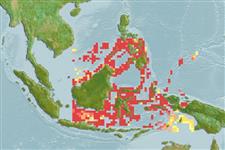Common names from other countries
Environment: milieu / climate zone / depth range / distribution range
Ecologia
. Tropical; 23°C - 30°C (Ref. 102835); 13°N - 9°S, 109°E - 139°E (Ref. 106696)
Western Central Pacific: Restricted in the tropical western Pacific. From Sabah, Malaysia to Palau, north to Philippines and south to Indonesia.
Length at first maturity / Tamanho / Peso / Idade
Maturity: Lm ? range ? - ? cm Max length : 41.1 cm SHL macho/indeterminado; (Ref. 117184); common length : 20.0 cm SHL macho/indeterminado; (Ref. 348)
Its shell is thinner and smoother than that of H. hippopus, usually devoid of pigmentation, and more semi-circular in profile. The mantle is similar to that of H. hippopus (Rosewater, 1982), except that prominent papillae line the margins of the incurrent siphon.
Collected for food and shell (Ref. 348).
Life cycle and mating behavior
Maturidade | Reprodução | Desova | Ovos | Fecundidade | Larvas
Broadcast spawners. Life cycle: Embryos develop into free-swimming trocophore larvae, succeeded by the bivalve veliger, resembling a miniature clam (Ref. 833).
Poutiers, J.M. 1998. (Ref. 348)
Status na Lista Vermelha da IUCN (Ref. 130435: Version 2024-1)
Status no CITES (Ref. 108899)
Not Evaluated
Perigo para os humanos
Harmless
Uso pelos humanos
Pescarias: espécies comerciais
FAO - Aquacultura: produção; | FishSource | Sea Around Us
Ferramentas
Fontes da internet
Estimates based on models
Resiliência
Baixo, tempo mínimo de duplicação da população 4,5 - 14 anos (K=0.13).
Vulnerabilidade
Moderate to high vulnerability (51 of 100).
Categoria de preço
Unknown.
